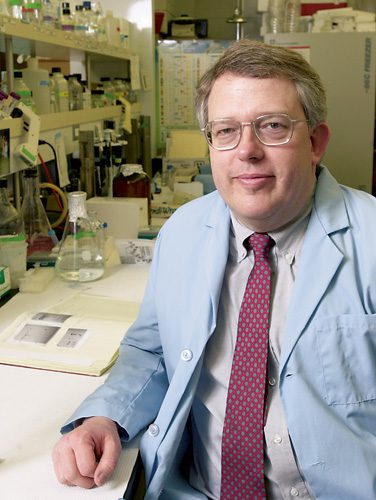After years of planning and months of digger around Mayan structures deep in the sultry Guatemalan jungle, BYU anthropology professor Stephen D. Houston was not going to let his fear of snakes keep him from getting the first glance at a monumental discovery.
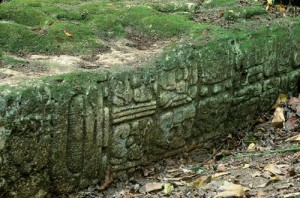
Houston, co-director of an extensive excavation of Mayan ruins at Piedras Negras, eagerly stuck his head in a hole that workers had dug underneath a huge limestone slab lying on its face. There were no snakes under the 3,000-pound stone, but Houston was more surprised by what he saw than he would have been by one of the vipers common to the area.
“I saw hands and a bit of a human profile, and I knew this was something,” Houston recalls now, nearly three years after the climactic discovery at Piedras Negras. “People abandoned their excavations to come see what was going on.”
Houston thus became the first person in more than 1,000 years to see the carvings on one of the largest Mayan panels known. The slab, dubbed Panel 15, measures 4 feet by 5 feet and is 6 inches thick.
“It’s rare that you find such a large piece of sculpture,” says Zachary N. Nelson, ’98, who worked on the project in 1999 and 2000 as a BYU graduate anthropology student. “Most of those have been discovered already.”
The panel lay face down in a stairwell, having fallen sometime in the ninth century from its perch high above the tomb of a king within the largest temple complex at Piedras Negras. Fortunately, lying as it did and being covered with debris preserved the sculptural and glyphic art on Panel 15 for centuries.
After his initial look, Houston anxiously waited while two dozen workers rigged a block and tackle to lift and flip the stone, which was then supported by burlap sacks filled with sand to keep it from breaking. Houston’s translation of the glyphs—along with other research at Piedras Negras by scholars from BYU and other universities—unravels the story of the rise and fall of a Pre-Columbian urban center of incredible vitality and sophistication.

A SACRED JUNGLE CITY
Around A.D. 400 just a few villagers lived at Piedras Negras when a wave of immigrants moved in. The influx, says Houston, was part of a larger population boom in the Mayan lowlands, which include what are today the southern Mexican states of Quintana Roo, Campeche, Tabasco, and Chiapas, and the northern Guatemalan department of El Petén.
The Maya quickly established a teeming civilization at Piedras Negras, complete with temples, ball courts, sweat baths, and a highly developed social hierarchy. At the center of their city, they built what archaeologists refer to as the “Acropolis”—a series of interconnected and layered royal pyramids set on a hill and towering some 400 feet above the Usumacinta River. Residential areas as far as two miles from the Acropolis suggest that Piedras Negras could have been home to tens of thousands of people at its zenith.
The height of civilization at Piedras Negras occurred between A.D. 500 and 800, when a series of seven holy kings reigned. The site’s spectacular architecture and informative hieroglyphic writing make it a window to Classic Maya culture, which flourished from A.D. 250 to 850 but then suddenly collapsed.
Although Piedras Negras was not the largest city in the lowlands, it is one of the most important for modern archaeologists because it has been well preserved. Piedras Negras is located in a remote jungle that is part of Guatemala’s Sierra del Lacandón National Park, and the inaccessibility of the site, combined with modern guerrilla warfare, has kept away tourists and looters, who might have destroyed the archaeological record.
The remote location also presents a deterrent for modern archaeologists: no roads lead to the site, and the transportation options include a two-day rafting trip along the Usumacinta or a five-hour walk from the Mexican town of Corregiadora Ortíz.
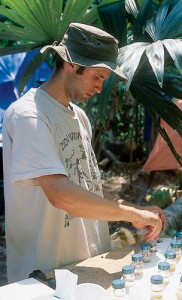
Codirected by Hector Escobedo of the Universidad del Valle de Guatemala, Houston’s study of Piedras Negras included seasonal excavations from 1997 to 2000 and additional lab work in Guatemala in 2001 and 2002. The Guatemalan Institute of Anthropology and History granted permits for the dig, which was the most ambitious archaeological project at the site since the University of Pennsylvania studied Piedras Negras in the 1930s. In that earlier project Pennsylvania professor J. Alden Mason and colleagues concentrated their studies on the city’s spectacular architectural structures, including the Acropolis. Pennsylvania researchers, however, had not extensively studied more modest structures and regional settlement patterns. Houston’s work to understand the common people of Piedras Negras may have been one of the most important contributions of his four-year dig at the site.
“It’s very significant,” says David L. Webster, an anthropology professor at Penn State University who accompanied Houston. “Nobody had really done the kind of archaeology that needed to be done in order to understand the larger issues with regard to this part of the Maya lowlands. Now, Piedras Negras is the only place where that has been done in the entire region.”
“Piedras Negras is an area that’s very poorly understood and had been studied under an entirely different set of standards in the 1930s,” says Houston, whose project was funded by the National Geographic Society, BYU, and other sources. “We opened up a vast part of the Mayan civilization simply by going in and documenting things.”
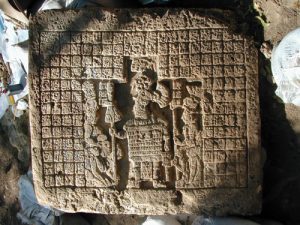
For instance, Houston’s team conducted sophisticated isotopic studies on the human remains found at the site, revealing that the rank and file subsisted primarily on maize (corn) and sweet potatoes. Noble families tended to have more meat in their diets.
Researchers also found that the city demonstrates unusually clear evidence of concern for the supernatural. Team members digging in house mounds miles from the king’s palace found large numbers of tiny figurines in the shape of humans, animals, and gods.
“They were obviously used for some kind of household rituals,” says Webster. “At other sites you almost never find anything of ritualistic importance in residential areas.”
These observations were supported by scores of burial sites found directly under terraced platforms that served as home sites for the commoners. Burying deceased family members under the floor of one’s house was a form of veneration for ancestors and is a sign that the Classic Maya culture maintained strong ties with the supernatural world, Webster says.
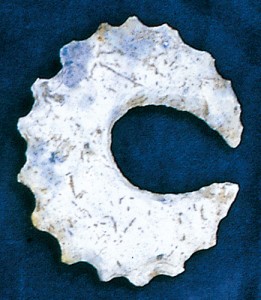
Another unusual aspect of life at Piedras Negras during the Classic Maya period was the pervasiveness of sweat baths, which the Maya likely used for worship as well as relaxation and cleansing. Researchers studied and reconstructed portions of eight large bathhouses near the Acropolis, but the team also discovered evidence of many bathhouses in outlying residential areas.
A STORY TOLD IN STONE
Panel 15 narrowly evaded discovery 70 years ago.
“The excavations in the 1930s had come within a few feet of the slab,” says Charles W. Golden, who was a PhD student at the University of Pennsylvania when the panel was discovered in April 2000 and who wrote a dissertation on the Acropolis. “It was covered with just a thin layer of debris.”
Soon after Panel 15 was discovered, Houston performed what he calls an “autopsy” on the panel—a close physical examination of the carvings using a flashlight and his fingers. “You get a feel for what is carving and what is erosion,” he says.
Houston, one of the world’s most talented and well-known Maya epigraphists, spent days deciphering the symbols on Panel 15. Researchers also took a series of photographs, which were used by Houston to trace a small-scale version of the panel.
The carving describes the life of Itsamk’anahk II, a Piedras Negras king who was born May 22, 626, and ascended to the throne at the tender age of 12. The second of seven holy kings described in hieroglyphs at Piedras Negras, Itsamk’anahk II reined in prosperity and exacted tribute from lesser kingdoms nearby.
Like other Mayan cities, Piedras Negras followed a king whom commoners regarded as “holy but not godly,” Houston says. “The king is a protector and intermediary. He is viewed as oracular or prophetic.”

After interpreting hieroglyphs and studying settlement patterns at Piedras Negras, Houston concluded that the city’s social structure included the overlord, or king, who established a loosely controlled cadre of lesser lords or governors, who ruled mini-fiefdoms on the outskirts of Piedras Negras and protected the heart of the city from attack by outside enemies.
The lesser lords waged battle on behalf of the king and brought him tribute of chocolate and captive prisoners, who were enslaved or sacrificed to the gods. While serving as the spiritual leader of the city, the Piedras Negras king—whom Houston describes as the “Dalai Lama with a penchant for warfare”—also commanded the armies that battled local rivals such as Yaxchilán, a city located 45 miles south of Piedras Negras along the Usumacinta River.
“You almost get a feeling of Sicilian-style violence,” Houston says. “There are grudges and vendettas. Someone is killed, and they preserve those memories through time.”
When Itsamk’anahk reached the age of 21, warriors under his command embarked on a series of battles in which they took captives, shown on the panel kneeling next to Itsamk’anahk’s lieutenants, who flank him.
Houston found the depiction of the captives to be one of the most fascinating aspects of Panel 15. The captives appear with pained looks on their faces, as if in supplication in anticipation of their demise.
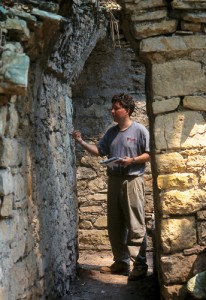
“It’s one of the first attempts at displaying emotion by the Mayas,” Houston says. “They don’t do it with their conquerors but the conquered. These Mayan artists are somehow given license to indulge their interest in emotion with the captives.”
Houston learned that Panel 15 was commissioned after Itsamk’anahk’s death by his son, a Piedras Negras ruler designated “Ruler 3.”
“This is probably, in a sense, a tombstone,” Houston says.
Before it fell, Panel 15 was located high above a series of terraced patios in the Acropolis. The carving, which Houston believes was painted, served as a billboard reminding those who came to the palace of the adventurous exploits of a former king.
For the Maya, such drawings were not just inanimate objects but were actually thought to be living parts of the people they represented, Houston says. Bowing down before Panel 15, therefore, would not have been unusual for Piedras Negras inhabitants who came to the palace.
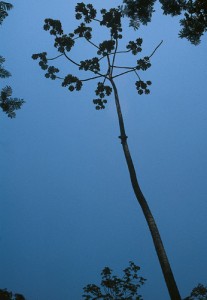
Ruler 3 was not himself revered in death as his father had been. A large tomb near the Acropolis, apparently intended for Ruler 3, was never completed. Rather, his contemporaries buried Ruler 3 under a nondescript platform in another part of the palace.
Like all civilizations of the past, the Classic Maya at Piedras Negras and in surrounding areas eventually suffered a period of decline. Unlike many civilizations, however, the fall of the Maya would happen suddenly.
About A.D. 810, according to the hieroglyphs interpreted by Houston, warriors from Yaxchilán sacked Piedras Negras’ royal palace and took the king captive. Although feeble attempts were made to restore the city’s former glory, Piedras Negras was abandoned within two generations of this crushing military defeat.
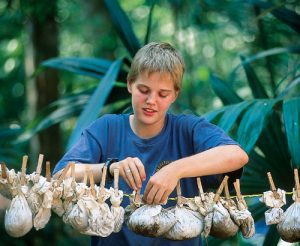
Conventional explanations attribute the Maya collapse to “drought, political instability, explosive and destructive population growth, and environmental destruction,” wrote Houston in a 1999 issue ofBYU Studies. And although Houston acknowledges that such things probably happened, he asserts that the fall of the Maya was almost certainly a “crisis of faith.” As disaster followed disaster, the people likely began to lose faith in their gods and in the kings, who were the gods’ intermediaries.
“Why feed and sustain local gods who do not keep their promises?” Houston asked in the BYU Studies article. “Why support kings who listen to useless deities?”
Houston suspects that Panel 15 remained in place on the wall of the large temple at Piedras Negras for some time after the city fell to its enemies and was abandoned.
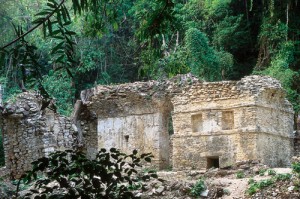
REMAINING MYSTERIES
Due to danger of flooding from the proposed dam on the Usumacinta River (see “The Race to Preserve Piedras Negras,” p. 60) and in accordance with BYU‘s concession from the Guatemalan government, Panel 15 was removed from Piedras Negras at the conclusion of the 2000 season and flown by U.S. Army helicopter to the National Museum in Guatemala City. There the panel may be viewed by all who care to learn about the life of Itsamk’anahk and the rise and fall of his kingdom.
In all, researchers on the project discovered, catalogued, and prepared for transfer to the Guatemalan government approximately five tons of pottery and other ceramic artifacts, several thousand pieces of obsidian and cherts used to make knives and axes, and 5,000 pieces of figurines. The team also transferred to a BYU lab in Guatemala City the remains of 120 people buried at Piedras Negras.
Houston is working to bring an exhibit containing some of the Piedras Negras artifacts as well as descriptions of the archaeological work done there to the BYU Museum of Art. He has also received grants from the Guggenheim Foundation and the School of American Research to write a book about Piedras Negras and two other books about the Classic Maya.
“I think that one of the strengths of this project was the scope it entailed,” says J. Jacob Parnell, ’99, who is now working on a PhD in soil sciences at Michigan State University. “It took in all aspects of the people and culture of this city.”
For his part, Houston would love to find Itsamk’anahk’s tomb, which he believes to be 120 feet under Panel 15’s original location.
Unfortunately, the physical condition of the Acropolis was simply too unstable for Houston’s team to attempt to unearth the tomb and its probable mother lode of jade and other fine objects. While Houston laments not finding the tomb, he knows that unsolved mysteries and unmet challenges are what make Piedras Negras so alluring.
“I’m almost certain it’s under there,” he says wistfully.
Ed Carter is a student at BYU’s J. Reuben Clark Law School.
FEEDBACK: Send comments on this article to magazine@byu.edu.
Related Articles (below): Jungle Life and The Race to Preserve Piedras Negras.
JUNGLE LIFE
By Edward L. Carter, ’96
A typical day at Piedras Negras was anything but typical for the 20 archaeology professors and students, 75 Guatemalan laborers, and handful of camp staff who called the remote jungle site home during April and May of each year from 1997 to 2000. Each day began with a 4:30 a.m. wake-up call from the monkeys in the trees overhead, followed at 6:30 a.m. by the toucans.
“You wake up with a pounding headache,” says BYU anthropology professor Stephen D. Houston, codirector of the project. “You get dressed and you feel dirty.”
After checking their shoes for scorpions and other critters, researchers and laborers alike gathered for breakfast—beans and rice—and then hiked to various excavation sites for a day of digging, sifting, and cataloging in 100-degree heat and overpowering humidity.
Upon quitting for the day, most headed to the Usumacinta River to bathe. Some tried fishing; others tried not to get caught by the fish. “The fish would bite you, with a painful result, unless you kept moving,” recalls Zachary X. Hruby, ’98, then a master’s student at BYU and now a PhD candidate at the University of California, Riverside.
After dinner (“usually rice and beans or beans and rice or some combination thereof,” Houston says) researchers would gather in a field lab constructed of saplings, vines, tarps, and mosquito netting. A generator provided power for lights, fans, and laptop computers, while a satellite phone allowed an occasional telephone call home at $3 per minute.
In addition to archaeological discoveries, excitement at the dig came from life in the jungle, although there were no major incidents with the Zapatista rebels who inhabit the jungle just across the Usumacinta River in Chiapas, Mexico, and who have been known to shoot at and rob river rafters near Piedras Negras. One project member slid 150 feet down a dry cenote, or well, and had to be fished out, and various illnesses passed through camp. BYU student J. Jacob Parnell, ’99, nearly stepped on a jumping viper and, on another occasion, lay down next to a tarantula. Still others discovered coral snakes and scorpions in their tents. BYU graduate anthropology student Zachary N. Nelson, ’98, had an encounter with a different kind of deadly predator common to the jungle—a jaguar.
“I was walking in the jungle along a trail that had recently been cut,” recalls Nelson, a Silverton, Ore., native who is now a PhD student at Penn State University. “I heard growling in a tree above me, and I yelled.
“Luckily, we headed opposite directions.”
THE RACE TO PRESERVE PIEDRAS NEGRAS
By Edward L. Carter, ’96
The source of life for the Maya who lived at Piedras Negras during the sixth, seventh, and eighth centuries could ultimately prove to be the means of obliterating much of the culture’s remains.
The Usumacinta River sustained life for thousands of Maya at Piedras Negras and other sites in the Mayan lowlands. Now the river is scheduled to be dammed and backed up into a reservoir under a proposal by the government of Mexico. While the government’s Tercer Milenio project proposes to improve the quality of life in southern Mexico and northern Guatemala by bringing jobs, tourists, and hydroelectric power, the project could also destroy irreplaceable and unstudied cultural and archaeological resources.
“Piedras Negras is definitely in danger, but there are sites closer to the dam that would be affected even more,” says BYU anthropology professor Stephen D. Houston, who will return to Piedras Negras in May 2003 to assess and prepare for the damage rising water would cause. “Many of them have never been explored except for brief visits in the late 19th century.”
The World Monument Fund, a private nonprofit organization based in New York, placed Piedras Negras on its 2002 list of “100 Most Endangered Sites” because of the threat of destruction by looting, erosion, and—potentially—flooding. The fund, along with American Express, made a grant that will allow Houston and other researchers to rebuild some structures at Piedras Negras to avoid further damage and to map other archaeological sites along the Usumacinta River that have yet to be studied in depth.
The 2003 project also will include research by BYU agronomists, led by Richard E. Terry, ’72, a professor of agronomy and horticulture. Terry’s research on Classic Maya agriculture has the potential to help modern Guatemala residents learn how to better practice sustainable use of soils and the forest in the Usumacinta River basin without engaging in destructive environmental practices, says Charles W. Golden, project director and a research associate at the University of Pennsylvania Museum.
The Mexican government proposal calls for a 100-meter dam at Boca del Cerro, located north of Piedras Negras on the border of the Mexican states of Tabasco and Chiapas. The dam probably would not cause complete flooding at Piedras Negras. The most affected areas would likely be low-lying residential portions that are key to understanding the social structure of the once vibrant city.
“The great loss would be never to have the opportunity to understand who most of the people were,” Houston says.









